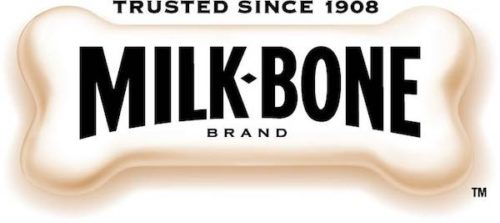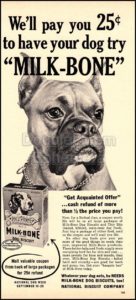
The original Milk-Bone® dog snack was created in 1908 by the F.H Bennett Biscuit Company at a bakery in the Lower East Side of New York City. The biscuits were originally called “Maltoid” (not to be confused with Altoid Mints which, when it’s on our breath, can clear a room full of Pulik), and was advertised as a supplemental dog biscuit made from wheat, vegetables, meat and wheat germ with added vitamins and minerals.
The company was in direct competition with the original dog biscuit, “Spratts Patent Meat Fibrine Dog Cakes.” The idea of  producing the dog biscuits in the shape of dog bones, however was entirely F.H. Bennett’s and it pushed the biscuits far ahead of the competition. Around 1920, the company made its fifth ingredient cow’s milk, and the name of the product was changed to “Milk-Bone.”
producing the dog biscuits in the shape of dog bones, however was entirely F.H. Bennett’s and it pushed the biscuits far ahead of the competition. Around 1920, the company made its fifth ingredient cow’s milk, and the name of the product was changed to “Milk-Bone.”
In 1931, the F.H. Bennett Company was purchased by the National Biscuit Company – or Nabisco. Nabisco advertised Milk Bones as “a dog’s dessert.” The marketing focus then shifted from Milk-Bone being merely a dog treat to a product that promoted cleaner teeth and better breath. Nabisco, under the ownership of Kraft Foods, sold the Milk-Bone rights over to Del Monte Foods in May 2006. As an aside, the biscuits first made at the FH Bennett bakery are now made exclusively in Buffalo, New York).
Aggressive marketing stressed how important the treats were central to a pet/owner relationship, and later, to a dog’s health, and early advertising featured purebred dogs on container of the treats. Baby-boomers were targeted in the 1950s with a print ads and a TV spot featuring the German Shepherd Dog, Rin Tin Tin, who, at the time, was the star of the hugely popular The Adventures of Rin Tin Tin. Different breeds that appeared on box packaging included a Beagle, Poodle, Westie, Boston Terrier, and Labrador Retriever.
A couple of years ago, “Rudy,” a Border Collie, helped sell Milk Bones in TV commercials like the one below:
A lot of us gave our dogs Milk Bones as when we were young dog owners, though of late, an article appeared explaining why the treat isn’t all that healthy for a dog. Snopes later addressed these concerns in a response that included a quote from our old pal, Dr. Jessica Vogelsang of Pawcurious. Our view is that dog owners need to investigate the food and treats they give their dogs, including ingredients and any recalls.
